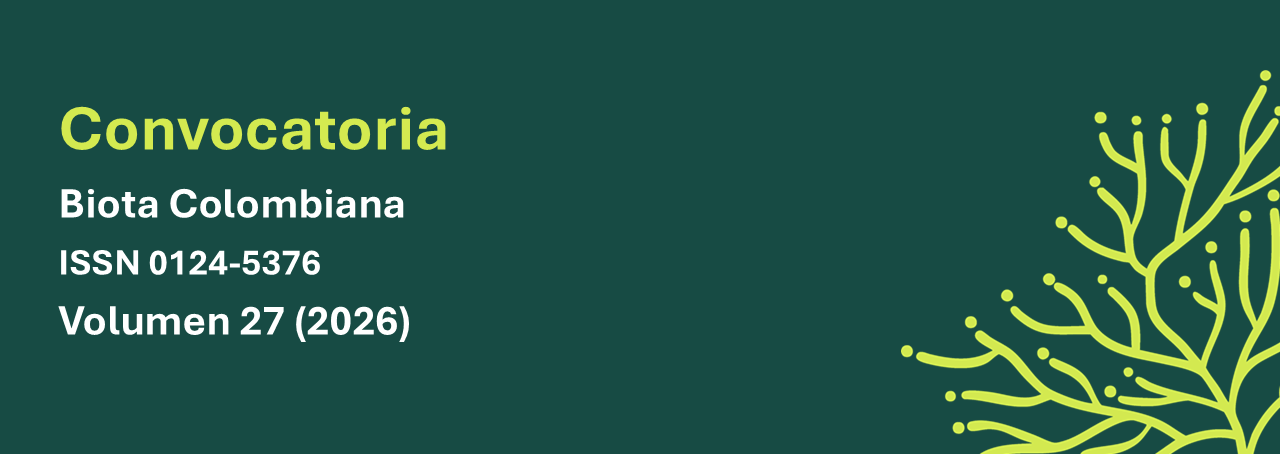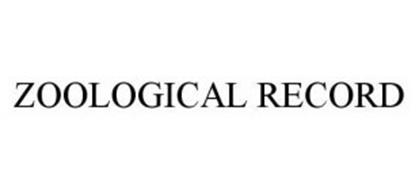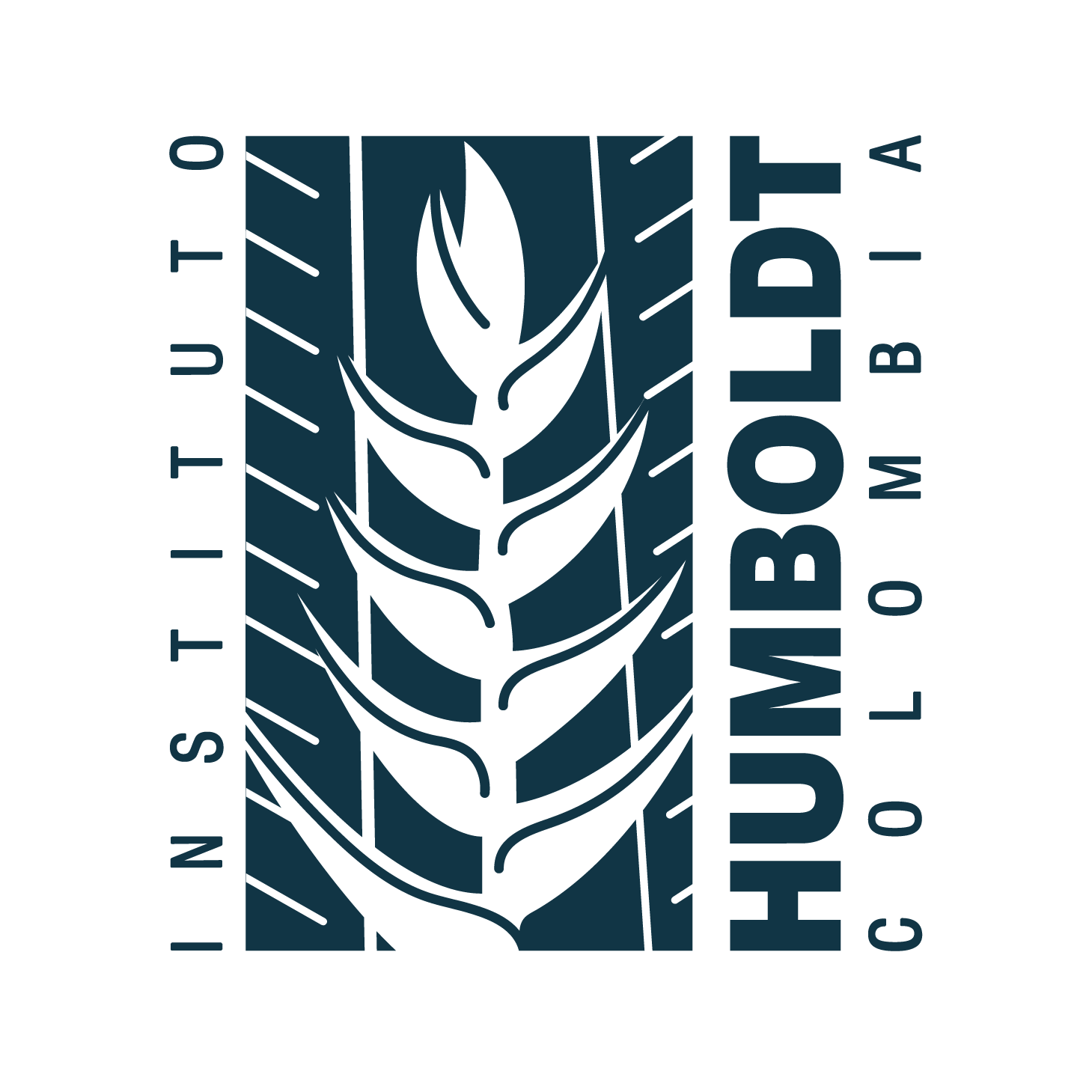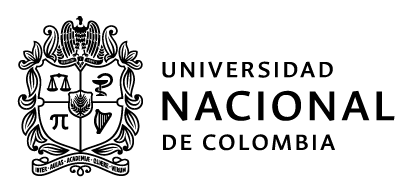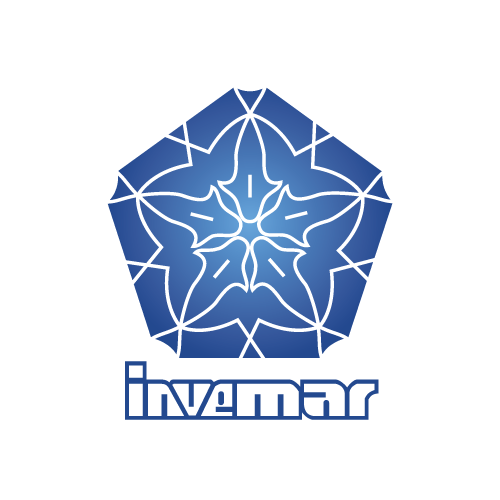Abstract (en):
Abstract (es):
Se realizó una evaluación de la diversidad de pseudoescorpiones en la región Andina nororiental de Colombia.
Se revisó la colección aracnológica del Instituto de Ciencias Naturales y se efectuaron muestreos en tres
sitios de los departamentos de Santander y Norte de Santander durante una semana mediante revisión manual
de cernido de hojarasca. Se estudiaron 94 ejemplares y se encontraron nueve morfoespecies pertenecientes
a seis géneros de las familias Tridenchthoniidae, Syarinidae, Olpiidae, Withiidae y Chernetidae. Se amplía
la distribución altitudinal de Ideobisium peckorum, geográfica de Ideobisium puertoricense y la familia
Tridenchthoniidae, la cual se registra por primera vez para Colombia.
Keywords:
Boyacá, Eastern mountain range, False scorpions, Norte de Santander, Santander (en)
References
Bedoya, E. 2015. Una nueva especie de Paraliochthonius (Pseudoscorpiones: Chthoniidae: Tyrannochthoniini) de Colombia. Revista Ibérica de Aracnología 26: 49-54.
Bedoya, E., G. Salleg y J. Quiros. 2014. Primer reporte de pseudoescorpiones (Arachnida: Pseudoscorpionida) en el departamento de Córdoba, caribe colombiano. Revista Colombiana de Ciencia Animal 6 (1): 177-183.
Bedoya, E., R. Bedoya y J. Quiros. 2015. Primer reporte del género Cryptocheiridium (Pseudoscorpiones: Cheiridiidae: Cheiridiinae) en Colombia. Revista Colombiana de Ciencia Animal 7 (1): 11-18.
Bedoya, E., G. Salleg, y J. Quiros. 2016. Sobre la ecología de pseudoescorpiones (Arachnida: Pseudoscorpiones) en
bosques de manglar del sur del Golfo de Morrosquillo, caribe colombiano. Revista Ibérica de Aracnología 28 (1): 65-74.
Beier, M. 1948. Phoresie and Phagophilie bei Pseudoscorpionen. Österreichische Zoologische Zeitschrift l: 441-497.
Beier, M. 1959. Zur Kenntnis der Pseudoscorpioniden- Fauna des Andengebietes. Beiträge zur Neotropischen Fauna 1: 185-228.
Brumfield, R.T. y S. Edwards. 2007. Evolution into and out of the Andes: a bayesian analysis of historical diversification in Thamnophilus antshrikes. Evolution 61 (2): 346-367.
Ceballos, A. y E. Florez. 2007. Pseudoescorpiones de Colombia (Arachnida: Pseudoscorpiones): lista actualizada de especies. Biota Colombiana 8: 47-51.
Celleri, R. 2010. Estado del conocimiento técnico científico sobre los servicios ambientales hidrológicos generados en los Andes. Pp: 25-46. En: Quintero, M. (Ed.). Servicios ambientales hidrológicos en la región andina. Estado del conocimiento, la acción y la política para asegurar su provisión mediante esquemas de pago por servicios ambientales. IEP; CONDESAN. Lima.
Chamberlin, J. C. 1931. The Arachnid Order Chelonetida. Stanford University Publications, Biological Sciences. Londres, 284 pp.
Chamberlin, J. C. 1962. New and little-known false scorpions, principally from caves, belonging to the families Chthoniidae and Neobisiidae (Arachnida, Chelonethida). Bulletin of the American Museum of Natural History 123: 303-352.
Chamberlin, J. C. y R.V. Chamberlin. 1945. The genera and species of the Tridenchthoniidae (Dithidae) a family of the arachnid order Chelonethida. Bulletin of the University of Utah 35 (23): 1-67.
Edward, K. L. y M. S. Harvey. 2008. Short-range endemism in hypogean environments: the pseudoscorpion genera Tyrannochthonius and Lagynochthonius (Pseudoscorpiones: Chthoniidae) in the semiarid zone of Western Australia. Invertebrate Systematics 22: 259-293.
Flórez, E. y H. Sánchez. 1995. La diversidad de los arácnidos en Colombia. Pp: 327-372. En: Rangel. O. (Ed.) Colombia Diversidad Biotica I. Universidad Nacional de Colombia, Inderena.
Gentry, A. H. 1982. Phytogeographic patterns as evidence for a Choco’ refuge. Pp: 112–136. En: Prance, G. T. (Ed.). Biological diversification in the tropics. Columbia University Press, Nueva York.
Gentry, A. 2001. Patrones de diversidad y composición florística en los bosques de las montañas tropicales. Pp: 85-123. En: Kapelle, M. y A. Brown (Eds.). Bosques nublados del Neotrópico. Instituto Nacional de Biodiversidad (INBIO). San José de Costa Rica.
Graham, C. H., S. R. Ron, J. C. Santos, C. J. Schneider, y C. Moritz. 2004. Integrating phylogenetics and environmental niche models to explore speciation mechanisms in dendrobatid frogs. Evolution 58: 1781-1793.
Haffer, J. 1967. Speciation in Colombian forest birds west of the Andes. American Museum Novitates 294: 1-57.
Harvey, M. S. 1992. The phylogeny and classification of the Pseudoscorpionida (Chelicerata: Arachnida). Invertebrate Taxonomy 6: 1373- 1435.
Harvey, M. S. 2002. The neglected cousins: what do we know about the smaller arachnid orders? Journal of Arachnology 30: 357-372.
Harvey, M. S. 2013. Pseudoscorpions of the World, version 3.0. Western Australian Museum, Perth. Disponible en: http://www.museum.wa.gov.au/catalogues/pseudoscorpions
Harvey, M. y F. Stahlavsky. 2009. A review of the pseudoscorpion genus Oreolpium (Pseudoscorpiones: Garypinidae), with remarks on the composition of the Garypinidae and on pseudoscorpions with bipolar distributions. Journal of Arachnology 38 (2): 294-308.
Harvey, M.S. y W. Muchmore. 2013. The systematics of the pseudoscorpion family Ideoroncidae (Pseudoscorpiones: Neobisioidea) in the New World. Journal of Arachnology 41 (3): 229-290.
Henderson, A., S.P. Churchill y J.L. Luteyn. 1991. Neotropical Plant Diversity. Nature 351: 21-22.
Hernandez, J. 1992. Caracterización geográfica de Colombia. Pp: 45-54. En: Halffter, G. (comp). La diversidad biológica de Iberoamérica I. Instituto de Ecología A. C. Xalapa.
Hughes, C. y R. Eastwood. 2006. Island radiation on a continental scale: exceptional rates of plant diversification after uplift of the Andes. Proceedings of the National Academy of Sciences. 103: 10334-10339.
Judson, M. 2007. A new and endangered species of the pseudoscorpion genus Lagynochthonius from a cave in Vietnam, with notes on chelal morphology and the composition of the Tyrannochthoniini (Arachnida, Chelonethi, Chthoniidae). Zootaxa 1627: 53-68.
Lacava, M., J. C. González-Gómez, J.C. Valenzuela-Rojas, C. Moncayo, L. Cardozo, E. Tizo-Pedroso & L.F. García. 2015. New cases of social parasitism among pseudoscorpions from Colombian populations. Ethology Ecology & Evolution 28 (4): 452-461.
Bedoya, E., R. Bedoya y J. Quiros. 2015. Primer reporte del género Cryptocheiridium (Pseudoscorpiones: Cheiridiidae: Cheiridiinae) en Colombia. Revista Colombiana de Ciencia Animal 7 (1): 11-18.
Bedoya, E., G. Salleg, y J. Quiros. 2016. Sobre la ecología de pseudoescorpiones (Arachnida: Pseudoscorpiones) en
bosques de manglar del sur del Golfo de Morrosquillo, caribe colombiano. Revista Ibérica de Aracnología 28 (1): 65-74.
Beier, M. 1948. Phoresie and Phagophilie bei Pseudoscorpionen. Österreichische Zoologische Zeitschrift l: 441-497.
Beier, M. 1959. Zur Kenntnis der Pseudoscorpioniden-Fauna des Andengebietes. Beiträge zur Neotropischen Fauna 1: 185-228.
Brumfield, R.T. y S. Edwards. 2007. Evolution into and out of the Andes: a bayesian analysis of historical diversification in Thamnophilus antshrikes. Evolution 61 (2): 346-367.
Ceballos, A. y E. Florez. 2007. Pseudoescorpiones de Colombia (Arachnida: Pseudoscorpiones): lista actualizada de especies. Biota Colombiana 8: 47-51.
Celleri, R. 2010. Estado del conocimiento técnico científico sobre los servicios ambientales hidrológicos generados en los Andes. Pp: 25-46. En: Quintero, M. (Ed.). Servicios ambientales hidrológicos en la región andina. Estado del conocimiento, la acción y la política para asegurar su provisión mediante esquemas de pago por servicios ambientales. IEP; CONDESAN. Lima.
Chamberlin, J. C. 1931. The Arachnid Order Chelonetida. Stanford University Publications, Biological Sciences. Londres, 284 pp.
Chamberlin, J. C. 1962. New and little-known false scorpions, principally from caves, belonging to the families Chthoniidae and Neobisiidae (Arachnida, Chelonethida). Bulletin of the American Museum of Natural History 123: 303-352.
Chamberlin, J. C. y R.V. Chamberlin. 1945. The genera and species of the Tridenchthoniidae (Dithidae) a family of the arachnid order Chelonethida. Bulletin of the University of Utah 35 (23): 1-67.
Edward, K. L. y M. S. Harvey. 2008. Short-range endemism in hypogean environments: the pseudoscorpion genera Tyrannochthonius and Lagynochthonius (Pseudoscorpiones: Chthoniidae) in the semiarid zone of Western Australia. Invertebrate Systematics 22: 259-293.
Flórez, E. y H. Sánchez. 1995. La diversidad de los arácnidos en Colombia. Pp: 327-372. En: Rangel. O. (Ed.) Colombia Diversidad Biotica I. Universidad Nacional de Colombia, Inderena.
Gentry, A. H. 1982. Phytogeographic patterns as evidence for a Choco’ refuge. Pp: 112–136. En: Prance, G. T. (Ed.). Biological diversification in the tropics. Columbia University Press, Nueva York.
Gentry, A. 2001. Patrones de diversidad y composición florística en los bosques de las montañas tropicales. Pp: 85-123. En: Kapelle, M. y A. Brown (Eds.). Bosques nublados del Neotrópico. Instituto Nacional de Biodiversidad (INBIO). San José de Costa Rica.
Graham, C. H., S. R. Ron, J. C. Santos, C. J. Schneider, y C. Moritz. 2004. Integrating phylogenetics and environmental niche models to explore speciation mechanisms in dendrobatid frogs. Evolution 58: 1781-1793.
Haffer, J. 1967. Speciation in Colombian forest birds west of the Andes. American Museum Novitates 294: 1-57.
Harvey, M. S. 1992. The phylogeny and classification of the Pseudoscorpionida (Chelicerata: Arachnida). Invertebrate Taxonomy 6: 1373- 1435.
Harvey, M. S. 2002. The neglected cousins: what do we know about the smaller arachnid orders? Journal of Arachnology 30: 357-372.
Harvey, M. S. 2013. Pseudoscorpions of the World, version 3.0. Western Australian Museum, Perth. Disponible en: http://www.museum.wa.gov.au/catalogues/pseudoscorpions
Harvey, M. y F. Stahlavsky. 2009. A review of the pseudoscorpion genus Oreolpium (Pseudoscorpiones: Garypinidae), with remarks on the composition of the Garypinidae and on pseudoscorpions with bipolar distributions. Journal of Arachnology 38 (2): 294-308.
Harvey, M.S. y W. Muchmore. 2013. The systematics of the pseudoscorpion family Ideoroncidae (Pseudoscorpiones: Neobisioidea) in the New World. Journal of Arachnology 41 (3): 229-290.
Henderson, A., S.P. Churchill y J.L. Luteyn. 1991. Neotropical Plant Diversity. Nature 351: 21-22.
Hernandez, J. 1992. Caracterización geográfica de Colombia. Pp: 45-54. En: Halffter, G. (comp). La diversidad biológica de Iberoamérica I. Instituto de Ecología A. C. Xalapa.
Hughes, C. y R. Eastwood. 2006. Island radiation on a continental scale: exceptional rates of plant diversification after uplift of the Andes. Proceedings of the National Academy of Sciences. 103: 10334-10339.
Judson, M. 2007. A new and endangered species of the pseudoscorpion genus Lagynochthonius from a cave in Vietnam, with notes on chelal morphology and the composition of the Tyrannochthoniini (Arachnida, Chelonethi, Chthoniidae). Zootaxa 1627: 53-68.
Lacava, M., J. C. González-Gómez, J.C. Valenzuela-Rojas, C. Moncayo, L. Cardozo, E. Tizo-Pedroso & L.F. García. 2015. New cases of social parasitism among pseudoscorpions from Colombian populations. Ethology Ecology & Evolution 28 (4): 452-461.
How to Cite
The works published in the journals of the Alexander von Humboldt Biological Resources Research Institute are subject to the following terms, in relation to copyright:
1. The patrimonial rights of the published works are assigned to Instituto de Investigación de Recursos Biológicos Alexander von Humboldt. The authors or institutions that elaborate the document agree to transfer the patrimonial rights to the Humboldt Institute with the sending of their articles, which allows, among other things, the reproduction, public communication, dissemination and dissemination of works.
2. The works of digital editions are published under a Creative Commons Colombia license:
Creative Commons License
This work is licensed under a Creative Commons Atribución-NoComercial-SinDerivar 4.0 Internacional.
> Attribution - Non-commercial - No Derivative: This license is the most restrictive of the six main licenses, it only allows others to download the works and share them with others, as long as their authorship is acknowledged, but they cannot be changed in any way, nor can they be used commercially.
3. The authors, when submitting articles to the editorial process of the magazines published by the Humboldt Institute, accept the institutional dispositions on copyright and open access.
4. All items received will be subjected to anti-plagiarism software. The submission of an article to the magazines of the Humboldt Institute is understood as the acceptance of the review to detect possible plagiarism.
5. The works submitted to the editing process of the magazines of the Humboldt Institute must be unpublished.



